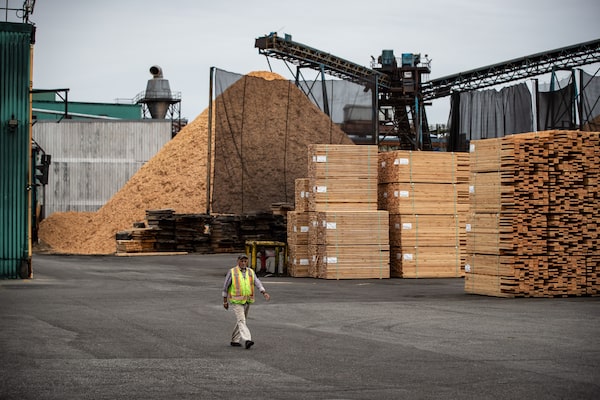
Stacks of lumber at Teal-Jones Group sawmill in Surrey, B.C., on May 30, 2021.DARRYL DYCK/The Canadian Press
The lumber market’s unprecedented rally is starting to falter but industry analysts predict wood prices will still be at historically lofty levels through 2022.
Random Lengths, an Oregon-based company that monitors wood markets, said two-by-fours made from Western spruce, pine and fir sold last week for US$1,470 for 1,000 board feet, a drop of US$130 compared with the previous weekly survey.
It marks the second consecutive week that the benchmark has fallen after peaking at US$1,630 in mid-May.
U.S. seeks to double tariff rates against most Canadian softwood lumber
“Framing lumber prices took their first significant move downward in 2021,” Random Lengths said in its industry newsletter. “Downward pressure intensified after the previous week’s moderate downturn.”
The benchmark has now decreased 10 per cent from its record high. But even with the latest decline, lumber cash prices – a gauge of what sawmills are charging to sell to wholesalers – are nearly four times higher than the benchmark at US$373 in early June of 2020.
Consumers embarking on renovation and remodelling projects won’t be noticing any immediate relief at the retail level. A spruce two-by-four framing wall stud that’s almost eight feet in length sold for $10 to $11 in Canada last week at some retail outlets, compared with less than $3.25 in early 2020.
Lumber cash prices have been on a choppy rally over the past 13 months, amid strong demand and constrained supply. There are signs, however, that the frenzy is subsiding. On the Chicago Mercantile Exchange, prices for lumber futures for July delivery have tumbled by one-quarter over the past four weeks.
While it’s unclear how long it might take for markets to stabilize, analysts expect that in this commodity cycle, the next trough won’t be nearly as deep as it has been in the past. Industry experts forecast a new era with a floor for lumber cash prices at higher levels, likely at a minimum of US$500 next year, or more than double the decade-low bottom of US$210 in 2011 and far higher than US$130 in 2009 during the recession.
Wood business consultant Russ Taylor said it appears that cash prices that hit record highs last month are now headed into a phase of drifting toward US$1,000 later this year. “My sense is that prices have peaked,” he said in an interview. “But very few producers are building new mills. They’re buying existing mills and modernizing.”
In May, 2019, during a slump in lumber markets, two-by-fours made from Western spruce, pine and fir sold for less than US$325 for 1,000 board feet – barely break-even at some B.C. sawmills.
“I think the new floor price is going to be up somewhere around US$500,” Mr. Taylor said.
Raymond James Ltd. analyst Daryl Swetlishoff envisages increased volatility in the months ahead. “We also forecast higher floor pricing as B.C. break-even cost levels increase and are upping our 2022 lumber price forecast by US$50 to US$600,” he said in a research note.
Higher pricing for when the market eventually bottoms would be good news for producers in British Columbia, where the costs of production at sawmills are higher than in the U.S. South. As Canada’s largest softwood lumber producer, B.C. accounted last year for 40 per cent of the country’s output.
After lumber markets slumped during the early stages of the pandemic, prices began jumping in mid-2020, as Canadians and Americans stuck at home embarked on do-it-yourself projects or hired contractors.
Two-by-fours made from Western spruce, pine and fir sold for an average of US$1,615 for 1,000 board feet last month, compared with US$366 in May of 2020, according to Vancouver-based industry newsletter Madison’s Lumber Reporter.
Keta Kosman, publisher of Madison’s Lumber Reporter, said U.S. duties on Canadian producers that sell softwood south of the border have resulted in higher costs for American home builders. She added that the rising Canadian dollar versus the American currency has eroded some of the gains of Canadian sawmills, whose costs are in Canadian dollars while export revenue is pegged to the U.S. greenback.
A report by Fastmarkets RISI, the publisher of Random Lengths, said the lumber imbalance between supply and demand lingers. “Lumber distributors and dealers are struggling to keep inventory stocked,” said the report by senior economist Dustin Jalbert and wood products team lead Jennifer Coskren.
Lumber demand began skyrocketing last summer as U.S. housing starts surged while homeowners redirected money normally spent on vacations to splurge instead on their homes, from undertaking interior repairs to building new decks.
“It appears that the spread of COVID-19, rather than dampening shelter demand, supercharged it as people spent more time than ever at home and felt a crunch for space,” said Mr. Jalbert and Ms. Coskren.
The boom in do-it-yourself projects is losing steam on the demand side, though timber supply constraints linger in British Columbia. B.C. is no longer a swing producer since it can’t ramp up output like it did 15 to 20 years ago, when the provincial government allowed producers to have a much larger harvest annually of timber.
British Columbia is still recovering from the impact of mountain pine beetles from 1999 to 2005, when forests were decimated by the insects in the province’s Interior. B.C. wildfires in 2017 and 2018 further depleted supplies of wood fibre.
The U.S. South has a glut of timber, but sawmill capacity hasn’t kept pace. “We have since seen some recovery as mill capacity has ramped up in the U.S. South, but industry output is still 11 per cent below its 2005 peak,” said the authors from Fastmarkets RISI.
Your time is valuable. Have the Top Business Headlines newsletter conveniently delivered to your inbox in the morning or evening. Sign up today.
 Brent Jang
Brent Jang